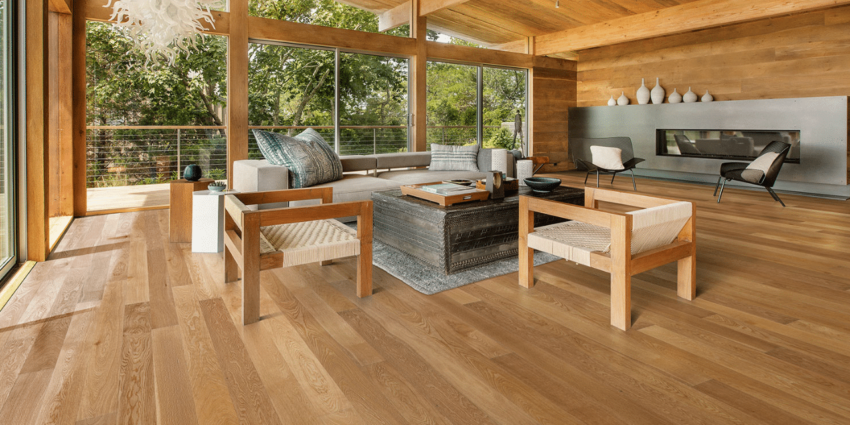As our awareness of environmental issues grows, more and more people are seeking eco-friendly alternatives for their homes. One area where sustainable choices can make a significant impact is flooring. Traditional flooring materials often have negative effects on the environment due to their production processes and disposal methods. However, a revolution is underway, offering a wide range of eco-friendly flooring options that are both stylish and sustainable. In this article, we will explore some of these innovative choices that can help transform your home into an environmentally conscious haven.
Why Eco-Friendly options?
You may be wondering exactly why eco-friendly options are being chosen more and more, and why we are recommending them. Well of course, the first and main reason is the fact that these floorings are good for the environment as they are made from recyclable, reused and/or readily available materials which haven’t generally been used before.
This results in flooring which still provides excellent quality, but comes from resources which haven’t been as overutilized as wood from your average tree has for example. This on its own won’t save the planet of course, but if many people take action a lot can be done to help the planet.
Carpet Flooring
Carpet flooring can also be made from eco-friendly materials. Wool is a popular choice due to its durability and natural resistance to dirt and stains. It also has excellent insulating properties, making it a great option for energy savings in colder climates. For those who prefer synthetic fibers, there are options made from recycled plastic bottles or other sustainable materials. No matter what type of flooring you choose, there are many eco-friendly options available that combine sustainability and style.
When it comes to carpet in Oliver BC, selecting the perfect flooring option for your home is essential. With a little research, you can find the perfect green flooring to match your design and budget needs while helping preserve our planet.
Bamboo Flooring
Bamboo flooring has gained popularity in recent years due to its sustainability and durability. Bamboo is a rapidly renewable resource, as it reaches maturity within 3-5 years compared to the decades required for hardwood trees. It also has a natural resistance to pests and requires minimal chemicals during processing. With its unique grain patterns and various finishes, bamboo flooring offers a beautiful and eco-friendly alternative to traditional hardwood floors.

Cork Flooring
Cork flooring is derived from the bark of cork oak trees, making it a renewable and eco-friendly choice. The bark is harvested without cutting down the trees, allowing them to regenerate and absorb carbon dioxide from the atmosphere. Cork flooring is comfortable to walk on, as it has natural cushioning properties and provides insulation against temperature and noise. Its natural antimicrobial properties make it a healthy option for those with allergies or respiratory sensitivities.
Reclaimed Wood Flooring
Reclaimed wood flooring gives new life to old wood sourced from barns, factories, and other demolished structures. By repurposing these materials, we can reduce the demand for new timber and minimize deforestation. Reclaimed wood floors have a unique character, showcasing the marks of their previous life, such as knots, nail holes, and weathering. They bring warmth and a sense of history to any space while reducing environmental impact.
Recycled Metal Tiles
For a modern and industrial look, consider recycled metal tiles for your flooring. Made from post-consumer and post-industrial metals, these tiles contribute to waste reduction and energy conservation. They are highly durable and suitable for high-traffic areas. Recycled metal tiles come in various finishes and patterns, allowing you to create a unique aesthetic while promoting sustainable practices.
Natural Linoleum
Often confused with vinyl flooring, natural linoleum is a sustainable option made from renewable materials. It consists of linseed oil, cork or wood flour, tree resins, and jute backing. Natural linoleum is biodegradable, hypoallergenic, and emits fewer volatile organic compounds (VOCs) than synthetic alternatives. It offers a wide range of colors and patterns to suit different design preferences, making it a versatile choice for eco-conscious homeowners.
Things to Consider
Before we round things up we do have a few things for you to keep in mind when selecting your flooring. While these floorings are incredible, you shouldn’t try to force them in places where they don’t work simply for the fact that they’re green. If you have rooms where they would work well then that’s great, but there really is no need to be putting them everywhere, including places where they don’t really functionally belong, such as for example putting some of these in bathrooms wouldn’t really be a good idea over the classic tiled floors that we all know and love. Do it where possible and that’s more than good enough.
Conclusion
The eco-friendly flooring revolution has opened up a world of sustainable options for homeowners, allowing them to create beautiful spaces while minimizing their environmental footprint. Bamboo flooring, cork flooring, reclaimed wood flooring, recycled metal tiles, and natural linoleum are just a few examples of the innovative choices available. By opting for these sustainable materials, you can contribute to a healthier planet and enjoy a stylish home that aligns with your eco-conscious values. Embrace the eco-friendly flooring revolution and make a positive impact on your living space and the world around you.






